The Use of Polymers in Road Construction: A Comprehensive Research
VerifiedAdded on 2020/05/11
|29
|11163
|308
Report
AI Summary
This research paper explores the application of polymers in road construction, focusing on how they improve road performance and durability. It begins with an introduction to the challenges faced by traditional road materials and highlights the benefits of using polymer-modified bitumen. The paper then delves into various types of polymers, including thermoplastic elastomers (such as SBS, SBR, and SIS), thermoplastic polymers (EVA, polypropylene, and polyethylene), and thermosetting polymers, detailing their properties and applications. A comprehensive literature review examines the advantages and disadvantages of these polymers in bitumen modification, supported by studies on specific polymers like SBS and EVA. The paper also includes summary and matrix tables to compare different polymer types and their impacts. Finally, it concludes with recommendations for future research and application of polymers in road construction, emphasizing the importance of selecting the right polymer to meet specific performance requirements and environmental considerations.
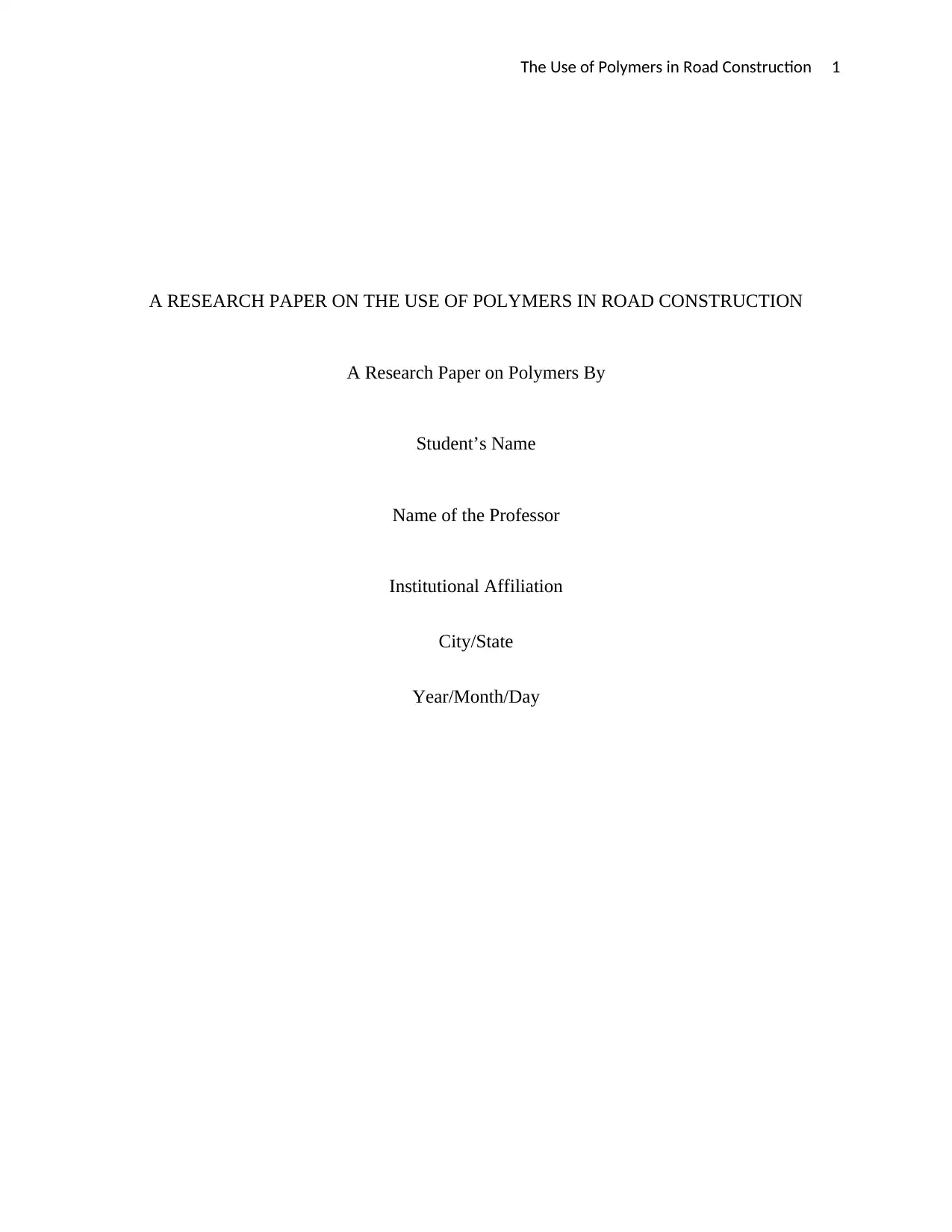
The Use of Polymers in Road Construction 1
A RESEARCH PAPER ON THE USE OF POLYMERS IN ROAD CONSTRUCTION
A Research Paper on Polymers By
Student’s Name
Name of the Professor
Institutional Affiliation
City/State
Year/Month/Day
A RESEARCH PAPER ON THE USE OF POLYMERS IN ROAD CONSTRUCTION
A Research Paper on Polymers By
Student’s Name
Name of the Professor
Institutional Affiliation
City/State
Year/Month/Day
Paraphrase This Document
Need a fresh take? Get an instant paraphrase of this document with our AI Paraphraser
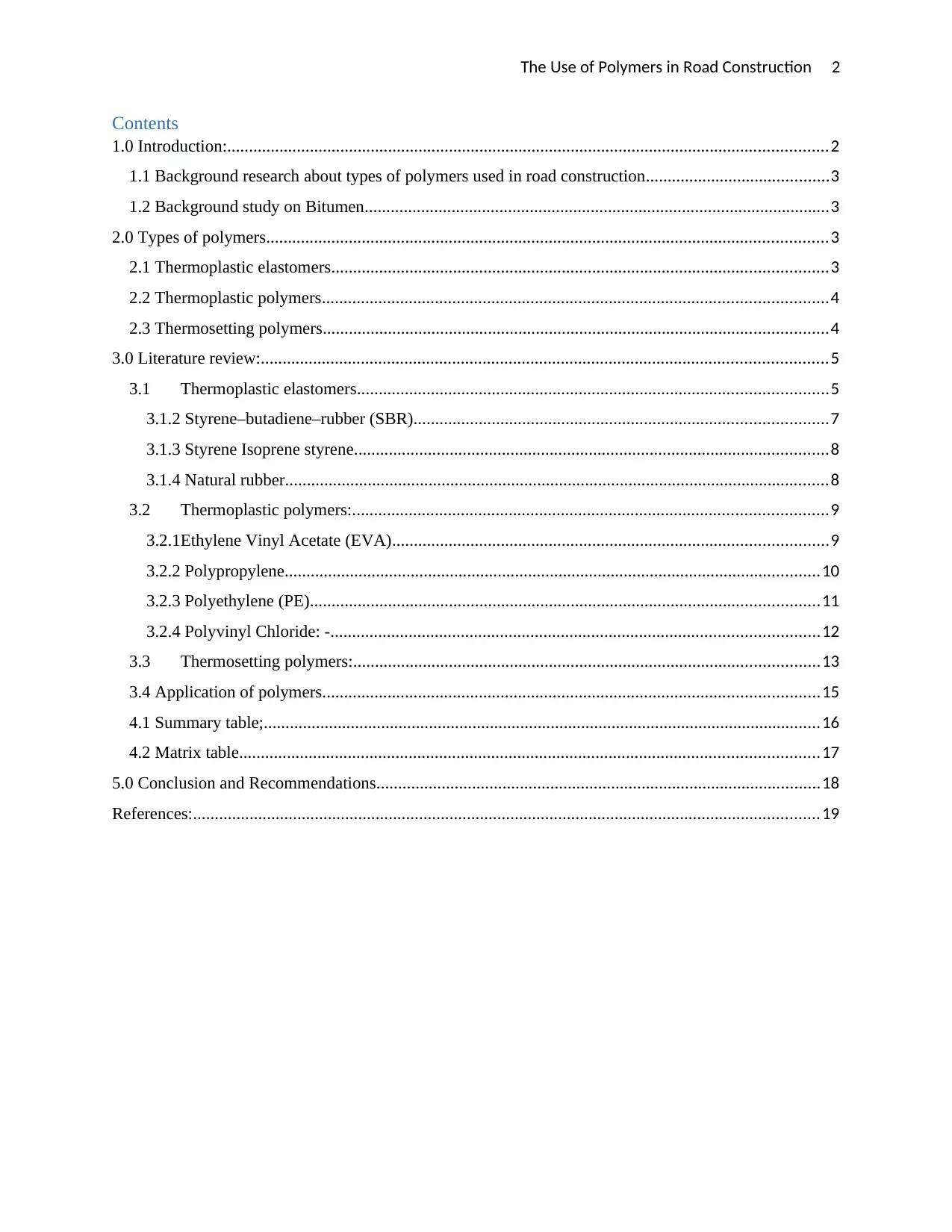
The Use of Polymers in Road Construction 2
Contents
1.0 Introduction:..........................................................................................................................................2
1.1 Background research about types of polymers used in road construction..........................................3
1.2 Background study on Bitumen...........................................................................................................3
2.0 Types of polymers.................................................................................................................................3
2.1 Thermoplastic elastomers..................................................................................................................3
2.2 Thermoplastic polymers....................................................................................................................4
2.3 Thermosetting polymers....................................................................................................................4
3.0 Literature review:..................................................................................................................................5
3.1 Thermoplastic elastomers............................................................................................................5
3.1.2 Styrene–butadiene–rubber (SBR)...............................................................................................7
3.1.3 Styrene Isoprene styrene.............................................................................................................8
3.1.4 Natural rubber.............................................................................................................................8
3.2 Thermoplastic polymers:.............................................................................................................9
3.2.1Ethylene Vinyl Acetate (EVA)....................................................................................................9
3.2.2 Polypropylene...........................................................................................................................10
3.2.3 Polyethylene (PE).....................................................................................................................11
3.2.4 Polyvinyl Chloride: -................................................................................................................12
3.3 Thermosetting polymers:...........................................................................................................13
3.4 Application of polymers..................................................................................................................15
4.1 Summary table;................................................................................................................................16
4.2 Matrix table.....................................................................................................................................17
5.0 Conclusion and Recommendations......................................................................................................18
References:................................................................................................................................................19
Contents
1.0 Introduction:..........................................................................................................................................2
1.1 Background research about types of polymers used in road construction..........................................3
1.2 Background study on Bitumen...........................................................................................................3
2.0 Types of polymers.................................................................................................................................3
2.1 Thermoplastic elastomers..................................................................................................................3
2.2 Thermoplastic polymers....................................................................................................................4
2.3 Thermosetting polymers....................................................................................................................4
3.0 Literature review:..................................................................................................................................5
3.1 Thermoplastic elastomers............................................................................................................5
3.1.2 Styrene–butadiene–rubber (SBR)...............................................................................................7
3.1.3 Styrene Isoprene styrene.............................................................................................................8
3.1.4 Natural rubber.............................................................................................................................8
3.2 Thermoplastic polymers:.............................................................................................................9
3.2.1Ethylene Vinyl Acetate (EVA)....................................................................................................9
3.2.2 Polypropylene...........................................................................................................................10
3.2.3 Polyethylene (PE).....................................................................................................................11
3.2.4 Polyvinyl Chloride: -................................................................................................................12
3.3 Thermosetting polymers:...........................................................................................................13
3.4 Application of polymers..................................................................................................................15
4.1 Summary table;................................................................................................................................16
4.2 Matrix table.....................................................................................................................................17
5.0 Conclusion and Recommendations......................................................................................................18
References:................................................................................................................................................19
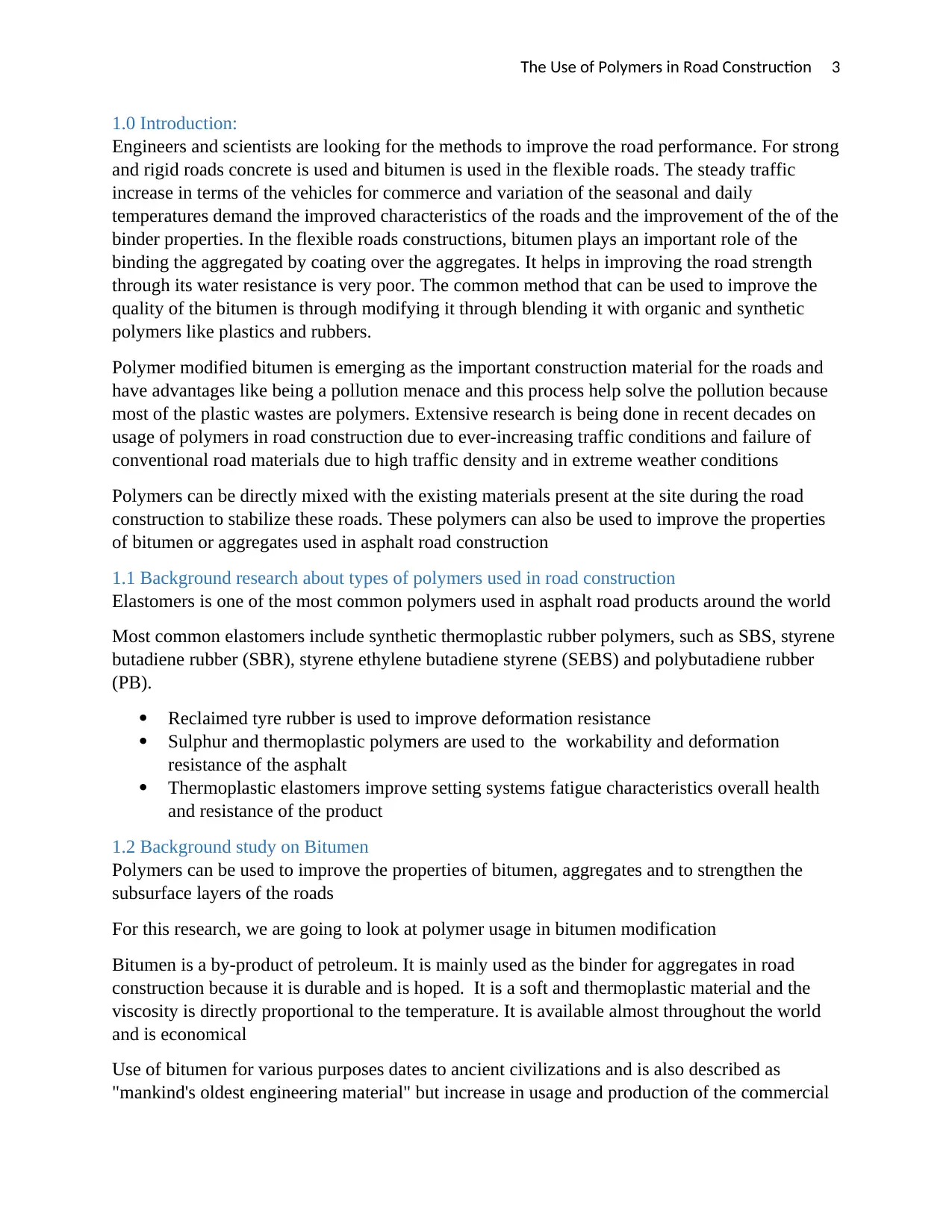
The Use of Polymers in Road Construction 3
1.0 Introduction:
Engineers and scientists are looking for the methods to improve the road performance. For strong
and rigid roads concrete is used and bitumen is used in the flexible roads. The steady traffic
increase in terms of the vehicles for commerce and variation of the seasonal and daily
temperatures demand the improved characteristics of the roads and the improvement of the of the
binder properties. In the flexible roads constructions, bitumen plays an important role of the
binding the aggregated by coating over the aggregates. It helps in improving the road strength
through its water resistance is very poor. The common method that can be used to improve the
quality of the bitumen is through modifying it through blending it with organic and synthetic
polymers like plastics and rubbers.
Polymer modified bitumen is emerging as the important construction material for the roads and
have advantages like being a pollution menace and this process help solve the pollution because
most of the plastic wastes are polymers. Extensive research is being done in recent decades on
usage of polymers in road construction due to ever-increasing traffic conditions and failure of
conventional road materials due to high traffic density and in extreme weather conditions
Polymers can be directly mixed with the existing materials present at the site during the road
construction to stabilize these roads. These polymers can also be used to improve the properties
of bitumen or aggregates used in asphalt road construction
1.1 Background research about types of polymers used in road construction
Elastomers is one of the most common polymers used in asphalt road products around the world
Most common elastomers include synthetic thermoplastic rubber polymers, such as SBS, styrene
butadiene rubber (SBR), styrene ethylene butadiene styrene (SEBS) and polybutadiene rubber
(PB).
Reclaimed tyre rubber is used to improve deformation resistance
Sulphur and thermoplastic polymers are used to the workability and deformation
resistance of the asphalt
Thermoplastic elastomers improve setting systems fatigue characteristics overall health
and resistance of the product
1.2 Background study on Bitumen
Polymers can be used to improve the properties of bitumen, aggregates and to strengthen the
subsurface layers of the roads
For this research, we are going to look at polymer usage in bitumen modification
Bitumen is a by-product of petroleum. It is mainly used as the binder for aggregates in road
construction because it is durable and is hoped. It is a soft and thermoplastic material and the
viscosity is directly proportional to the temperature. It is available almost throughout the world
and is economical
Use of bitumen for various purposes dates to ancient civilizations and is also described as
"mankind's oldest engineering material" but increase in usage and production of the commercial
1.0 Introduction:
Engineers and scientists are looking for the methods to improve the road performance. For strong
and rigid roads concrete is used and bitumen is used in the flexible roads. The steady traffic
increase in terms of the vehicles for commerce and variation of the seasonal and daily
temperatures demand the improved characteristics of the roads and the improvement of the of the
binder properties. In the flexible roads constructions, bitumen plays an important role of the
binding the aggregated by coating over the aggregates. It helps in improving the road strength
through its water resistance is very poor. The common method that can be used to improve the
quality of the bitumen is through modifying it through blending it with organic and synthetic
polymers like plastics and rubbers.
Polymer modified bitumen is emerging as the important construction material for the roads and
have advantages like being a pollution menace and this process help solve the pollution because
most of the plastic wastes are polymers. Extensive research is being done in recent decades on
usage of polymers in road construction due to ever-increasing traffic conditions and failure of
conventional road materials due to high traffic density and in extreme weather conditions
Polymers can be directly mixed with the existing materials present at the site during the road
construction to stabilize these roads. These polymers can also be used to improve the properties
of bitumen or aggregates used in asphalt road construction
1.1 Background research about types of polymers used in road construction
Elastomers is one of the most common polymers used in asphalt road products around the world
Most common elastomers include synthetic thermoplastic rubber polymers, such as SBS, styrene
butadiene rubber (SBR), styrene ethylene butadiene styrene (SEBS) and polybutadiene rubber
(PB).
Reclaimed tyre rubber is used to improve deformation resistance
Sulphur and thermoplastic polymers are used to the workability and deformation
resistance of the asphalt
Thermoplastic elastomers improve setting systems fatigue characteristics overall health
and resistance of the product
1.2 Background study on Bitumen
Polymers can be used to improve the properties of bitumen, aggregates and to strengthen the
subsurface layers of the roads
For this research, we are going to look at polymer usage in bitumen modification
Bitumen is a by-product of petroleum. It is mainly used as the binder for aggregates in road
construction because it is durable and is hoped. It is a soft and thermoplastic material and the
viscosity is directly proportional to the temperature. It is available almost throughout the world
and is economical
Use of bitumen for various purposes dates to ancient civilizations and is also described as
"mankind's oldest engineering material" but increase in usage and production of the commercial
⊘ This is a preview!⊘
Do you want full access?
Subscribe today to unlock all pages.

Trusted by 1+ million students worldwide
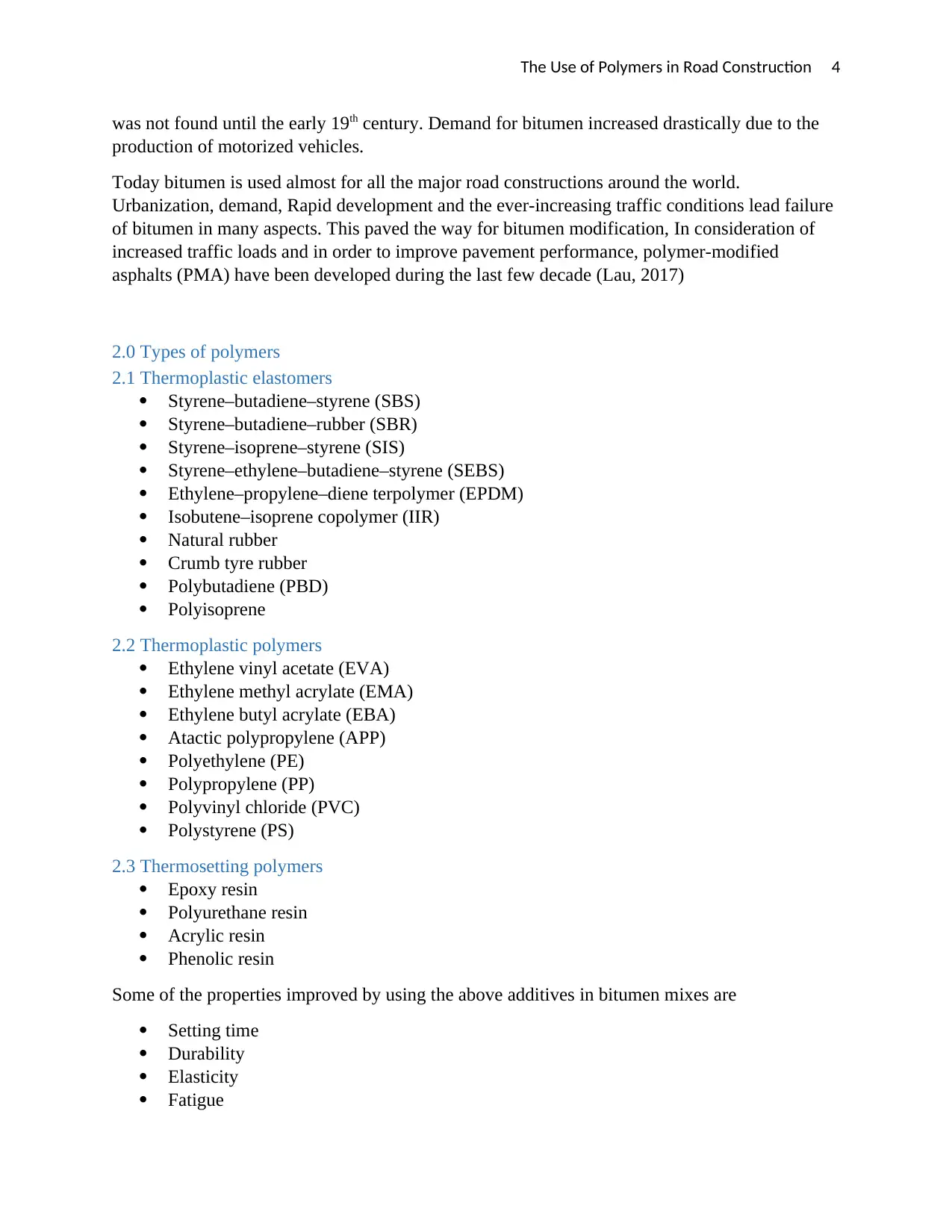
The Use of Polymers in Road Construction 4
was not found until the early 19th century. Demand for bitumen increased drastically due to the
production of motorized vehicles.
Today bitumen is used almost for all the major road constructions around the world.
Urbanization, demand, Rapid development and the ever-increasing traffic conditions lead failure
of bitumen in many aspects. This paved the way for bitumen modification, In consideration of
increased traffic loads and in order to improve pavement performance, polymer-modified
asphalts (PMA) have been developed during the last few decade (Lau, 2017)
2.0 Types of polymers
2.1 Thermoplastic elastomers
Styrene–butadiene–styrene (SBS)
Styrene–butadiene–rubber (SBR)
Styrene–isoprene–styrene (SIS)
Styrene–ethylene–butadiene–styrene (SEBS)
Ethylene–propylene–diene terpolymer (EPDM)
Isobutene–isoprene copolymer (IIR)
Natural rubber
Crumb tyre rubber
Polybutadiene (PBD)
Polyisoprene
2.2 Thermoplastic polymers
Ethylene vinyl acetate (EVA)
Ethylene methyl acrylate (EMA)
Ethylene butyl acrylate (EBA)
Atactic polypropylene (APP)
Polyethylene (PE)
Polypropylene (PP)
Polyvinyl chloride (PVC)
Polystyrene (PS)
2.3 Thermosetting polymers
Epoxy resin
Polyurethane resin
Acrylic resin
Phenolic resin
Some of the properties improved by using the above additives in bitumen mixes are
Setting time
Durability
Elasticity
Fatigue
was not found until the early 19th century. Demand for bitumen increased drastically due to the
production of motorized vehicles.
Today bitumen is used almost for all the major road constructions around the world.
Urbanization, demand, Rapid development and the ever-increasing traffic conditions lead failure
of bitumen in many aspects. This paved the way for bitumen modification, In consideration of
increased traffic loads and in order to improve pavement performance, polymer-modified
asphalts (PMA) have been developed during the last few decade (Lau, 2017)
2.0 Types of polymers
2.1 Thermoplastic elastomers
Styrene–butadiene–styrene (SBS)
Styrene–butadiene–rubber (SBR)
Styrene–isoprene–styrene (SIS)
Styrene–ethylene–butadiene–styrene (SEBS)
Ethylene–propylene–diene terpolymer (EPDM)
Isobutene–isoprene copolymer (IIR)
Natural rubber
Crumb tyre rubber
Polybutadiene (PBD)
Polyisoprene
2.2 Thermoplastic polymers
Ethylene vinyl acetate (EVA)
Ethylene methyl acrylate (EMA)
Ethylene butyl acrylate (EBA)
Atactic polypropylene (APP)
Polyethylene (PE)
Polypropylene (PP)
Polyvinyl chloride (PVC)
Polystyrene (PS)
2.3 Thermosetting polymers
Epoxy resin
Polyurethane resin
Acrylic resin
Phenolic resin
Some of the properties improved by using the above additives in bitumen mixes are
Setting time
Durability
Elasticity
Fatigue
Paraphrase This Document
Need a fresh take? Get an instant paraphrase of this document with our AI Paraphraser

The Use of Polymers in Road Construction 5
Resistance to deformation etc
Polymer coated aggregate (PCA) is also another type of polymer used in road construction where
the aggregates are coated with polymers to increase their binding property.
Resistance to deformation etc
Polymer coated aggregate (PCA) is also another type of polymer used in road construction where
the aggregates are coated with polymers to increase their binding property.
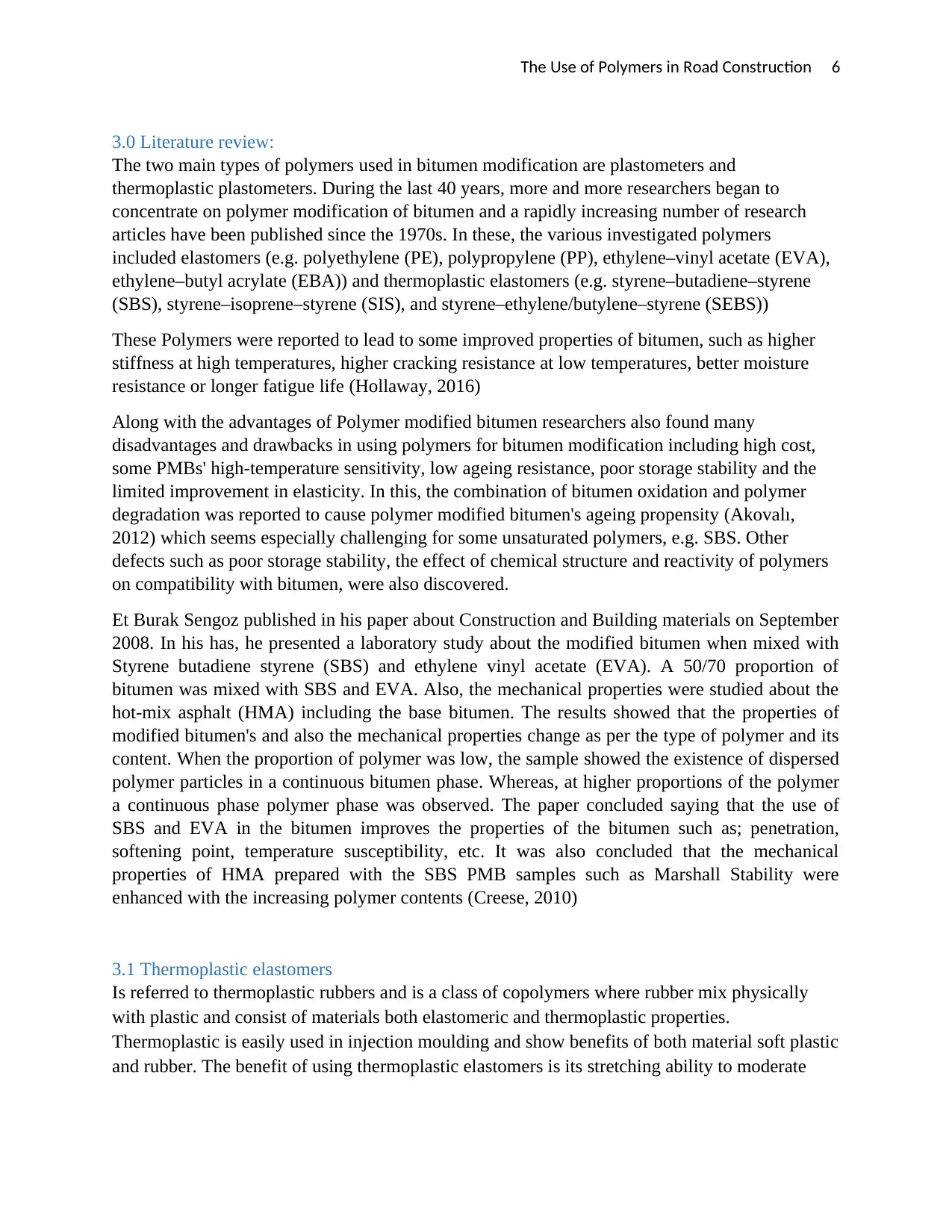
The Use of Polymers in Road Construction 6
3.0 Literature review:
The two main types of polymers used in bitumen modification are plastometers and
thermoplastic plastometers. During the last 40 years, more and more researchers began to
concentrate on polymer modification of bitumen and a rapidly increasing number of research
articles have been published since the 1970s. In these, the various investigated polymers
included elastomers (e.g. polyethylene (PE), polypropylene (PP), ethylene–vinyl acetate (EVA),
ethylene–butyl acrylate (EBA)) and thermoplastic elastomers (e.g. styrene–butadiene–styrene
(SBS), styrene–isoprene–styrene (SIS), and styrene–ethylene/butylene–styrene (SEBS))
These Polymers were reported to lead to some improved properties of bitumen, such as higher
stiffness at high temperatures, higher cracking resistance at low temperatures, better moisture
resistance or longer fatigue life (Hollaway, 2016)
Along with the advantages of Polymer modified bitumen researchers also found many
disadvantages and drawbacks in using polymers for bitumen modification including high cost,
some PMBs' high-temperature sensitivity, low ageing resistance, poor storage stability and the
limited improvement in elasticity. In this, the combination of bitumen oxidation and polymer
degradation was reported to cause polymer modified bitumen's ageing propensity (Akovalı,
2012) which seems especially challenging for some unsaturated polymers, e.g. SBS. Other
defects such as poor storage stability, the effect of chemical structure and reactivity of polymers
on compatibility with bitumen, were also discovered.
Et Burak Sengoz published in his paper about Construction and Building materials on September
2008. In his has, he presented a laboratory study about the modified bitumen when mixed with
Styrene butadiene styrene (SBS) and ethylene vinyl acetate (EVA). A 50/70 proportion of
bitumen was mixed with SBS and EVA. Also, the mechanical properties were studied about the
hot-mix asphalt (HMA) including the base bitumen. The results showed that the properties of
modified bitumen's and also the mechanical properties change as per the type of polymer and its
content. When the proportion of polymer was low, the sample showed the existence of dispersed
polymer particles in a continuous bitumen phase. Whereas, at higher proportions of the polymer
a continuous phase polymer phase was observed. The paper concluded saying that the use of
SBS and EVA in the bitumen improves the properties of the bitumen such as; penetration,
softening point, temperature susceptibility, etc. It was also concluded that the mechanical
properties of HMA prepared with the SBS PMB samples such as Marshall Stability were
enhanced with the increasing polymer contents (Creese, 2010)
3.1 Thermoplastic elastomers
Is referred to thermoplastic rubbers and is a class of copolymers where rubber mix physically
with plastic and consist of materials both elastomeric and thermoplastic properties.
Thermoplastic is easily used in injection moulding and show benefits of both material soft plastic
and rubber. The benefit of using thermoplastic elastomers is its stretching ability to moderate
3.0 Literature review:
The two main types of polymers used in bitumen modification are plastometers and
thermoplastic plastometers. During the last 40 years, more and more researchers began to
concentrate on polymer modification of bitumen and a rapidly increasing number of research
articles have been published since the 1970s. In these, the various investigated polymers
included elastomers (e.g. polyethylene (PE), polypropylene (PP), ethylene–vinyl acetate (EVA),
ethylene–butyl acrylate (EBA)) and thermoplastic elastomers (e.g. styrene–butadiene–styrene
(SBS), styrene–isoprene–styrene (SIS), and styrene–ethylene/butylene–styrene (SEBS))
These Polymers were reported to lead to some improved properties of bitumen, such as higher
stiffness at high temperatures, higher cracking resistance at low temperatures, better moisture
resistance or longer fatigue life (Hollaway, 2016)
Along with the advantages of Polymer modified bitumen researchers also found many
disadvantages and drawbacks in using polymers for bitumen modification including high cost,
some PMBs' high-temperature sensitivity, low ageing resistance, poor storage stability and the
limited improvement in elasticity. In this, the combination of bitumen oxidation and polymer
degradation was reported to cause polymer modified bitumen's ageing propensity (Akovalı,
2012) which seems especially challenging for some unsaturated polymers, e.g. SBS. Other
defects such as poor storage stability, the effect of chemical structure and reactivity of polymers
on compatibility with bitumen, were also discovered.
Et Burak Sengoz published in his paper about Construction and Building materials on September
2008. In his has, he presented a laboratory study about the modified bitumen when mixed with
Styrene butadiene styrene (SBS) and ethylene vinyl acetate (EVA). A 50/70 proportion of
bitumen was mixed with SBS and EVA. Also, the mechanical properties were studied about the
hot-mix asphalt (HMA) including the base bitumen. The results showed that the properties of
modified bitumen's and also the mechanical properties change as per the type of polymer and its
content. When the proportion of polymer was low, the sample showed the existence of dispersed
polymer particles in a continuous bitumen phase. Whereas, at higher proportions of the polymer
a continuous phase polymer phase was observed. The paper concluded saying that the use of
SBS and EVA in the bitumen improves the properties of the bitumen such as; penetration,
softening point, temperature susceptibility, etc. It was also concluded that the mechanical
properties of HMA prepared with the SBS PMB samples such as Marshall Stability were
enhanced with the increasing polymer contents (Creese, 2010)
3.1 Thermoplastic elastomers
Is referred to thermoplastic rubbers and is a class of copolymers where rubber mix physically
with plastic and consist of materials both elastomeric and thermoplastic properties.
Thermoplastic is easily used in injection moulding and show benefits of both material soft plastic
and rubber. The benefit of using thermoplastic elastomers is its stretching ability to moderate
⊘ This is a preview!⊘
Do you want full access?
Subscribe today to unlock all pages.

Trusted by 1+ million students worldwide
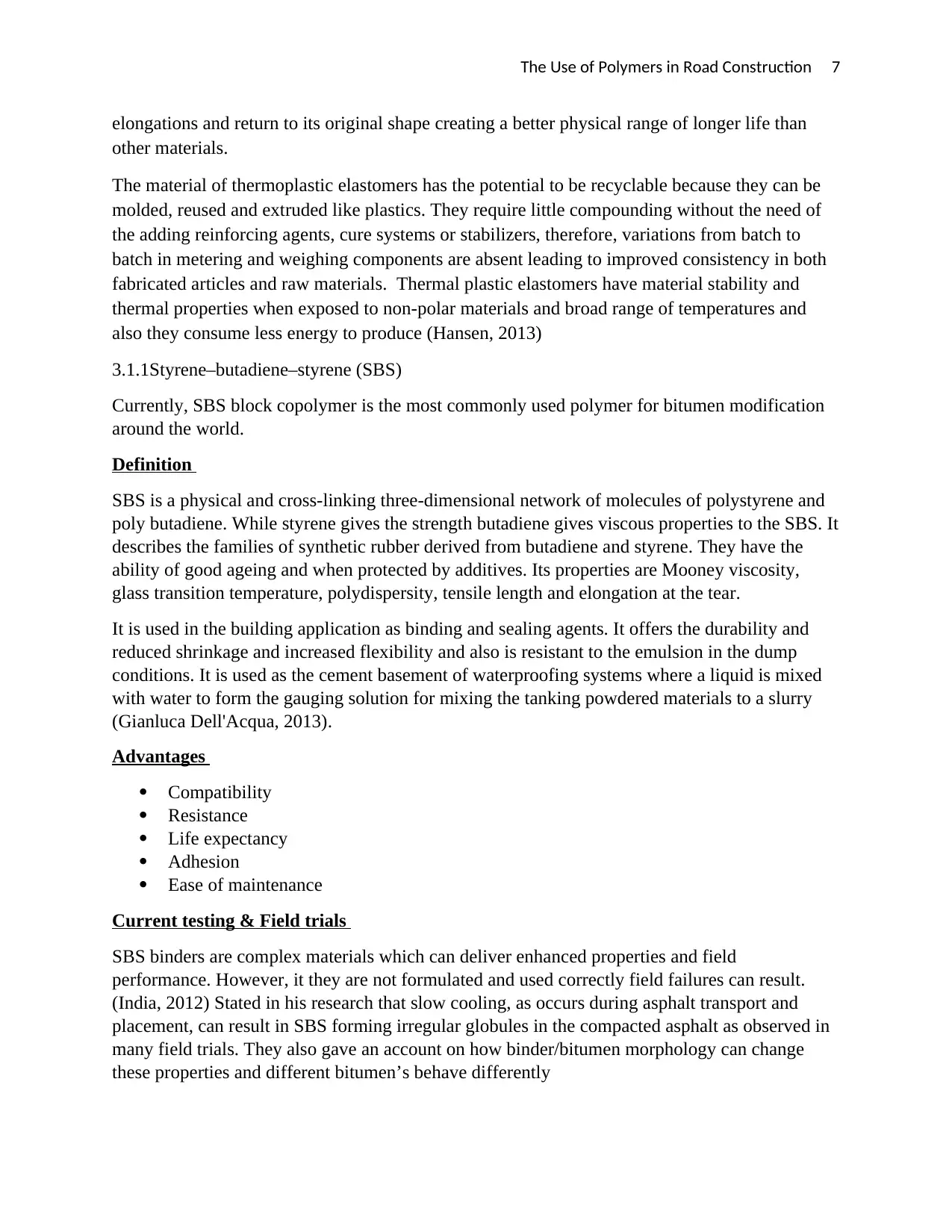
The Use of Polymers in Road Construction 7
elongations and return to its original shape creating a better physical range of longer life than
other materials.
The material of thermoplastic elastomers has the potential to be recyclable because they can be
molded, reused and extruded like plastics. They require little compounding without the need of
the adding reinforcing agents, cure systems or stabilizers, therefore, variations from batch to
batch in metering and weighing components are absent leading to improved consistency in both
fabricated articles and raw materials. Thermal plastic elastomers have material stability and
thermal properties when exposed to non-polar materials and broad range of temperatures and
also they consume less energy to produce (Hansen, 2013)
3.1.1Styrene–butadiene–styrene (SBS)
Currently, SBS block copolymer is the most commonly used polymer for bitumen modification
around the world.
Definition
SBS is a physical and cross-linking three-dimensional network of molecules of polystyrene and
poly butadiene. While styrene gives the strength butadiene gives viscous properties to the SBS. It
describes the families of synthetic rubber derived from butadiene and styrene. They have the
ability of good ageing and when protected by additives. Its properties are Mooney viscosity,
glass transition temperature, polydispersity, tensile length and elongation at the tear.
It is used in the building application as binding and sealing agents. It offers the durability and
reduced shrinkage and increased flexibility and also is resistant to the emulsion in the dump
conditions. It is used as the cement basement of waterproofing systems where a liquid is mixed
with water to form the gauging solution for mixing the tanking powdered materials to a slurry
(Gianluca Dell'Acqua, 2013).
Advantages
Compatibility
Resistance
Life expectancy
Adhesion
Ease of maintenance
Current testing & Field trials
SBS binders are complex materials which can deliver enhanced properties and field
performance. However, it they are not formulated and used correctly field failures can result.
(India, 2012) Stated in his research that slow cooling, as occurs during asphalt transport and
placement, can result in SBS forming irregular globules in the compacted asphalt as observed in
many field trials. They also gave an account on how binder/bitumen morphology can change
these properties and different bitumen’s behave differently
elongations and return to its original shape creating a better physical range of longer life than
other materials.
The material of thermoplastic elastomers has the potential to be recyclable because they can be
molded, reused and extruded like plastics. They require little compounding without the need of
the adding reinforcing agents, cure systems or stabilizers, therefore, variations from batch to
batch in metering and weighing components are absent leading to improved consistency in both
fabricated articles and raw materials. Thermal plastic elastomers have material stability and
thermal properties when exposed to non-polar materials and broad range of temperatures and
also they consume less energy to produce (Hansen, 2013)
3.1.1Styrene–butadiene–styrene (SBS)
Currently, SBS block copolymer is the most commonly used polymer for bitumen modification
around the world.
Definition
SBS is a physical and cross-linking three-dimensional network of molecules of polystyrene and
poly butadiene. While styrene gives the strength butadiene gives viscous properties to the SBS. It
describes the families of synthetic rubber derived from butadiene and styrene. They have the
ability of good ageing and when protected by additives. Its properties are Mooney viscosity,
glass transition temperature, polydispersity, tensile length and elongation at the tear.
It is used in the building application as binding and sealing agents. It offers the durability and
reduced shrinkage and increased flexibility and also is resistant to the emulsion in the dump
conditions. It is used as the cement basement of waterproofing systems where a liquid is mixed
with water to form the gauging solution for mixing the tanking powdered materials to a slurry
(Gianluca Dell'Acqua, 2013).
Advantages
Compatibility
Resistance
Life expectancy
Adhesion
Ease of maintenance
Current testing & Field trials
SBS binders are complex materials which can deliver enhanced properties and field
performance. However, it they are not formulated and used correctly field failures can result.
(India, 2012) Stated in his research that slow cooling, as occurs during asphalt transport and
placement, can result in SBS forming irregular globules in the compacted asphalt as observed in
many field trials. They also gave an account on how binder/bitumen morphology can change
these properties and different bitumen’s behave differently
Paraphrase This Document
Need a fresh take? Get an instant paraphrase of this document with our AI Paraphraser
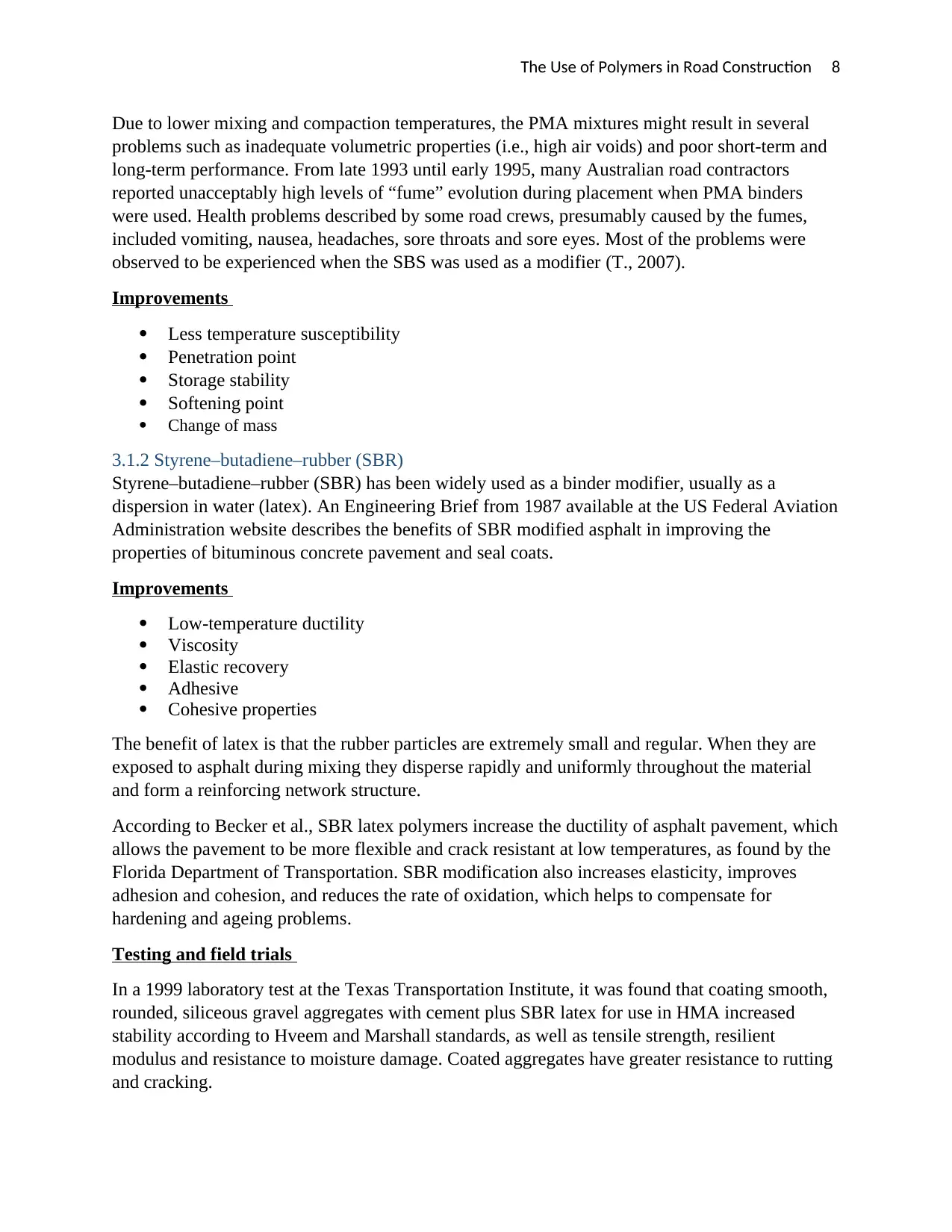
The Use of Polymers in Road Construction 8
Due to lower mixing and compaction temperatures, the PMA mixtures might result in several
problems such as inadequate volumetric properties (i.e., high air voids) and poor short-term and
long-term performance. From late 1993 until early 1995, many Australian road contractors
reported unacceptably high levels of “fume” evolution during placement when PMA binders
were used. Health problems described by some road crews, presumably caused by the fumes,
included vomiting, nausea, headaches, sore throats and sore eyes. Most of the problems were
observed to be experienced when the SBS was used as a modifier (T., 2007).
Improvements
Less temperature susceptibility
Penetration point
Storage stability
Softening point
Change of mass
3.1.2 Styrene–butadiene–rubber (SBR)
Styrene–butadiene–rubber (SBR) has been widely used as a binder modifier, usually as a
dispersion in water (latex). An Engineering Brief from 1987 available at the US Federal Aviation
Administration website describes the benefits of SBR modified asphalt in improving the
properties of bituminous concrete pavement and seal coats.
Improvements
Low-temperature ductility
Viscosity
Elastic recovery
Adhesive
Cohesive properties
The benefit of latex is that the rubber particles are extremely small and regular. When they are
exposed to asphalt during mixing they disperse rapidly and uniformly throughout the material
and form a reinforcing network structure.
According to Becker et al., SBR latex polymers increase the ductility of asphalt pavement, which
allows the pavement to be more flexible and crack resistant at low temperatures, as found by the
Florida Department of Transportation. SBR modification also increases elasticity, improves
adhesion and cohesion, and reduces the rate of oxidation, which helps to compensate for
hardening and ageing problems.
Testing and field trials
In a 1999 laboratory test at the Texas Transportation Institute, it was found that coating smooth,
rounded, siliceous gravel aggregates with cement plus SBR latex for use in HMA increased
stability according to Hveem and Marshall standards, as well as tensile strength, resilient
modulus and resistance to moisture damage. Coated aggregates have greater resistance to rutting
and cracking.
Due to lower mixing and compaction temperatures, the PMA mixtures might result in several
problems such as inadequate volumetric properties (i.e., high air voids) and poor short-term and
long-term performance. From late 1993 until early 1995, many Australian road contractors
reported unacceptably high levels of “fume” evolution during placement when PMA binders
were used. Health problems described by some road crews, presumably caused by the fumes,
included vomiting, nausea, headaches, sore throats and sore eyes. Most of the problems were
observed to be experienced when the SBS was used as a modifier (T., 2007).
Improvements
Less temperature susceptibility
Penetration point
Storage stability
Softening point
Change of mass
3.1.2 Styrene–butadiene–rubber (SBR)
Styrene–butadiene–rubber (SBR) has been widely used as a binder modifier, usually as a
dispersion in water (latex). An Engineering Brief from 1987 available at the US Federal Aviation
Administration website describes the benefits of SBR modified asphalt in improving the
properties of bituminous concrete pavement and seal coats.
Improvements
Low-temperature ductility
Viscosity
Elastic recovery
Adhesive
Cohesive properties
The benefit of latex is that the rubber particles are extremely small and regular. When they are
exposed to asphalt during mixing they disperse rapidly and uniformly throughout the material
and form a reinforcing network structure.
According to Becker et al., SBR latex polymers increase the ductility of asphalt pavement, which
allows the pavement to be more flexible and crack resistant at low temperatures, as found by the
Florida Department of Transportation. SBR modification also increases elasticity, improves
adhesion and cohesion, and reduces the rate of oxidation, which helps to compensate for
hardening and ageing problems.
Testing and field trials
In a 1999 laboratory test at the Texas Transportation Institute, it was found that coating smooth,
rounded, siliceous gravel aggregates with cement plus SBR latex for use in HMA increased
stability according to Hveem and Marshall standards, as well as tensile strength, resilient
modulus and resistance to moisture damage. Coated aggregates have greater resistance to rutting
and cracking.
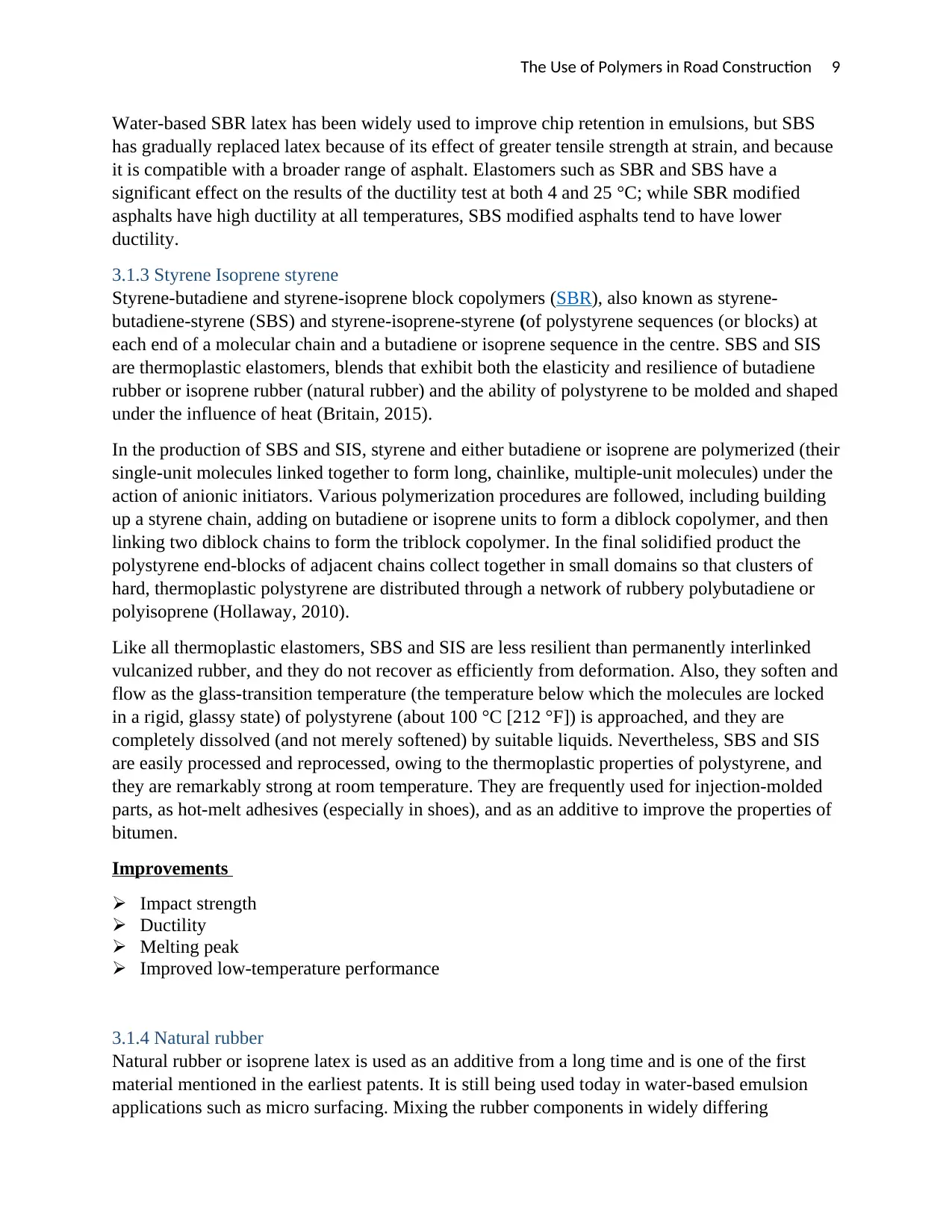
The Use of Polymers in Road Construction 9
Water-based SBR latex has been widely used to improve chip retention in emulsions, but SBS
has gradually replaced latex because of its effect of greater tensile strength at strain, and because
it is compatible with a broader range of asphalt. Elastomers such as SBR and SBS have a
significant effect on the results of the ductility test at both 4 and 25 °C; while SBR modified
asphalts have high ductility at all temperatures, SBS modified asphalts tend to have lower
ductility.
3.1.3 Styrene Isoprene styrene
Styrene-butadiene and styrene-isoprene block copolymers (SBR), also known as styrene-
butadiene-styrene (SBS) and styrene-isoprene-styrene (of polystyrene sequences (or blocks) at
each end of a molecular chain and a butadiene or isoprene sequence in the centre. SBS and SIS
are thermoplastic elastomers, blends that exhibit both the elasticity and resilience of butadiene
rubber or isoprene rubber (natural rubber) and the ability of polystyrene to be molded and shaped
under the influence of heat (Britain, 2015).
In the production of SBS and SIS, styrene and either butadiene or isoprene are polymerized (their
single-unit molecules linked together to form long, chainlike, multiple-unit molecules) under the
action of anionic initiators. Various polymerization procedures are followed, including building
up a styrene chain, adding on butadiene or isoprene units to form a diblock copolymer, and then
linking two diblock chains to form the triblock copolymer. In the final solidified product the
polystyrene end-blocks of adjacent chains collect together in small domains so that clusters of
hard, thermoplastic polystyrene are distributed through a network of rubbery polybutadiene or
polyisoprene (Hollaway, 2010).
Like all thermoplastic elastomers, SBS and SIS are less resilient than permanently interlinked
vulcanized rubber, and they do not recover as efficiently from deformation. Also, they soften and
flow as the glass-transition temperature (the temperature below which the molecules are locked
in a rigid, glassy state) of polystyrene (about 100 °C [212 °F]) is approached, and they are
completely dissolved (and not merely softened) by suitable liquids. Nevertheless, SBS and SIS
are easily processed and reprocessed, owing to the thermoplastic properties of polystyrene, and
they are remarkably strong at room temperature. They are frequently used for injection-molded
parts, as hot-melt adhesives (especially in shoes), and as an additive to improve the properties of
bitumen.
Improvements
Impact strength
Ductility
Melting peak
Improved low-temperature performance
3.1.4 Natural rubber
Natural rubber or isoprene latex is used as an additive from a long time and is one of the first
material mentioned in the earliest patents. It is still being used today in water-based emulsion
applications such as micro surfacing. Mixing the rubber components in widely differing
Water-based SBR latex has been widely used to improve chip retention in emulsions, but SBS
has gradually replaced latex because of its effect of greater tensile strength at strain, and because
it is compatible with a broader range of asphalt. Elastomers such as SBR and SBS have a
significant effect on the results of the ductility test at both 4 and 25 °C; while SBR modified
asphalts have high ductility at all temperatures, SBS modified asphalts tend to have lower
ductility.
3.1.3 Styrene Isoprene styrene
Styrene-butadiene and styrene-isoprene block copolymers (SBR), also known as styrene-
butadiene-styrene (SBS) and styrene-isoprene-styrene (of polystyrene sequences (or blocks) at
each end of a molecular chain and a butadiene or isoprene sequence in the centre. SBS and SIS
are thermoplastic elastomers, blends that exhibit both the elasticity and resilience of butadiene
rubber or isoprene rubber (natural rubber) and the ability of polystyrene to be molded and shaped
under the influence of heat (Britain, 2015).
In the production of SBS and SIS, styrene and either butadiene or isoprene are polymerized (their
single-unit molecules linked together to form long, chainlike, multiple-unit molecules) under the
action of anionic initiators. Various polymerization procedures are followed, including building
up a styrene chain, adding on butadiene or isoprene units to form a diblock copolymer, and then
linking two diblock chains to form the triblock copolymer. In the final solidified product the
polystyrene end-blocks of adjacent chains collect together in small domains so that clusters of
hard, thermoplastic polystyrene are distributed through a network of rubbery polybutadiene or
polyisoprene (Hollaway, 2010).
Like all thermoplastic elastomers, SBS and SIS are less resilient than permanently interlinked
vulcanized rubber, and they do not recover as efficiently from deformation. Also, they soften and
flow as the glass-transition temperature (the temperature below which the molecules are locked
in a rigid, glassy state) of polystyrene (about 100 °C [212 °F]) is approached, and they are
completely dissolved (and not merely softened) by suitable liquids. Nevertheless, SBS and SIS
are easily processed and reprocessed, owing to the thermoplastic properties of polystyrene, and
they are remarkably strong at room temperature. They are frequently used for injection-molded
parts, as hot-melt adhesives (especially in shoes), and as an additive to improve the properties of
bitumen.
Improvements
Impact strength
Ductility
Melting peak
Improved low-temperature performance
3.1.4 Natural rubber
Natural rubber or isoprene latex is used as an additive from a long time and is one of the first
material mentioned in the earliest patents. It is still being used today in water-based emulsion
applications such as micro surfacing. Mixing the rubber components in widely differing
⊘ This is a preview!⊘
Do you want full access?
Subscribe today to unlock all pages.

Trusted by 1+ million students worldwide
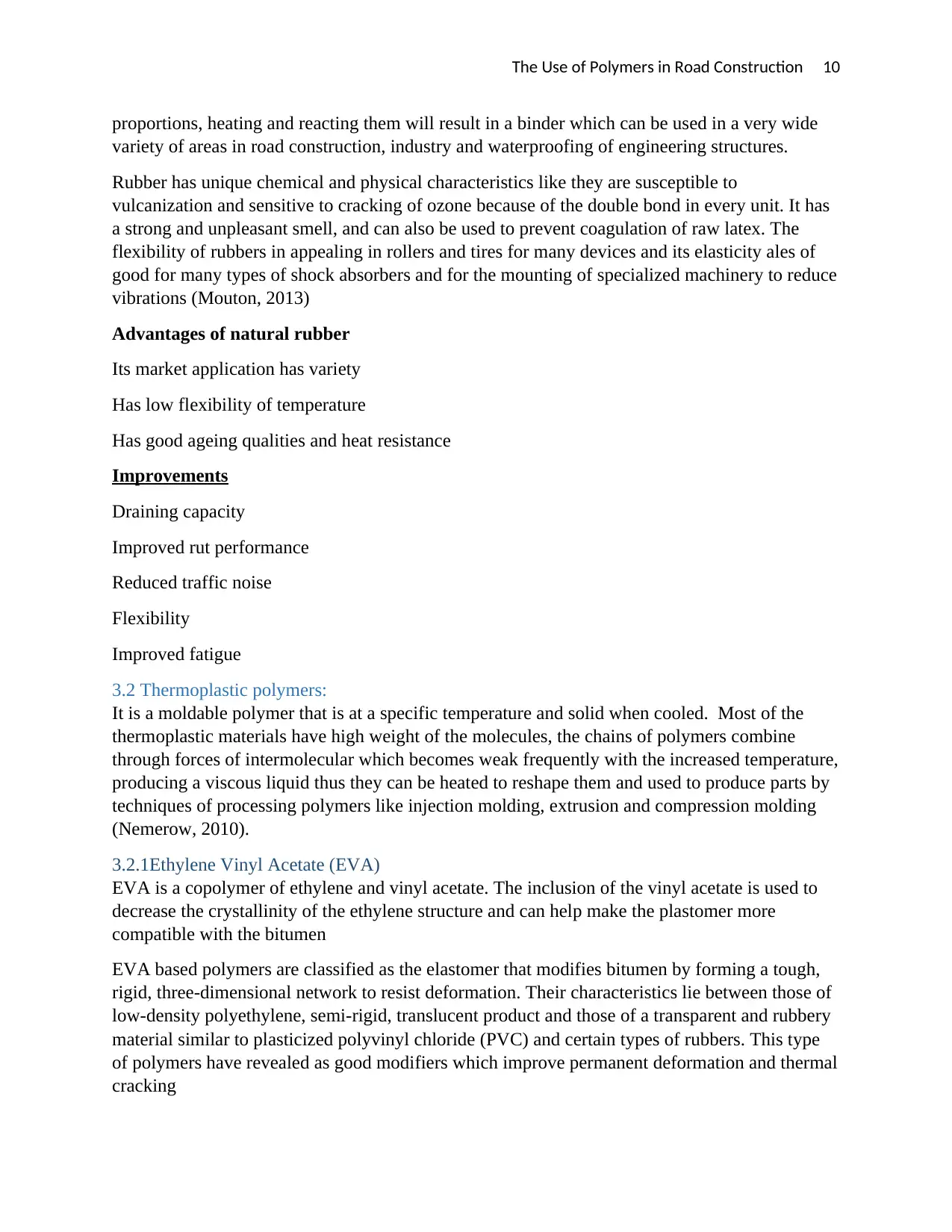
The Use of Polymers in Road Construction 10
proportions, heating and reacting them will result in a binder which can be used in a very wide
variety of areas in road construction, industry and waterproofing of engineering structures.
Rubber has unique chemical and physical characteristics like they are susceptible to
vulcanization and sensitive to cracking of ozone because of the double bond in every unit. It has
a strong and unpleasant smell, and can also be used to prevent coagulation of raw latex. The
flexibility of rubbers in appealing in rollers and tires for many devices and its elasticity ales of
good for many types of shock absorbers and for the mounting of specialized machinery to reduce
vibrations (Mouton, 2013)
Advantages of natural rubber
Its market application has variety
Has low flexibility of temperature
Has good ageing qualities and heat resistance
Improvements
Draining capacity
Improved rut performance
Reduced traffic noise
Flexibility
Improved fatigue
3.2 Thermoplastic polymers:
It is a moldable polymer that is at a specific temperature and solid when cooled. Most of the
thermoplastic materials have high weight of the molecules, the chains of polymers combine
through forces of intermolecular which becomes weak frequently with the increased temperature,
producing a viscous liquid thus they can be heated to reshape them and used to produce parts by
techniques of processing polymers like injection molding, extrusion and compression molding
(Nemerow, 2010).
3.2.1Ethylene Vinyl Acetate (EVA)
EVA is a copolymer of ethylene and vinyl acetate. The inclusion of the vinyl acetate is used to
decrease the crystallinity of the ethylene structure and can help make the plastomer more
compatible with the bitumen
EVA based polymers are classified as the elastomer that modifies bitumen by forming a tough,
rigid, three-dimensional network to resist deformation. Their characteristics lie between those of
low-density polyethylene, semi-rigid, translucent product and those of a transparent and rubbery
material similar to plasticized polyvinyl chloride (PVC) and certain types of rubbers. This type
of polymers have revealed as good modifiers which improve permanent deformation and thermal
cracking
proportions, heating and reacting them will result in a binder which can be used in a very wide
variety of areas in road construction, industry and waterproofing of engineering structures.
Rubber has unique chemical and physical characteristics like they are susceptible to
vulcanization and sensitive to cracking of ozone because of the double bond in every unit. It has
a strong and unpleasant smell, and can also be used to prevent coagulation of raw latex. The
flexibility of rubbers in appealing in rollers and tires for many devices and its elasticity ales of
good for many types of shock absorbers and for the mounting of specialized machinery to reduce
vibrations (Mouton, 2013)
Advantages of natural rubber
Its market application has variety
Has low flexibility of temperature
Has good ageing qualities and heat resistance
Improvements
Draining capacity
Improved rut performance
Reduced traffic noise
Flexibility
Improved fatigue
3.2 Thermoplastic polymers:
It is a moldable polymer that is at a specific temperature and solid when cooled. Most of the
thermoplastic materials have high weight of the molecules, the chains of polymers combine
through forces of intermolecular which becomes weak frequently with the increased temperature,
producing a viscous liquid thus they can be heated to reshape them and used to produce parts by
techniques of processing polymers like injection molding, extrusion and compression molding
(Nemerow, 2010).
3.2.1Ethylene Vinyl Acetate (EVA)
EVA is a copolymer of ethylene and vinyl acetate. The inclusion of the vinyl acetate is used to
decrease the crystallinity of the ethylene structure and can help make the plastomer more
compatible with the bitumen
EVA based polymers are classified as the elastomer that modifies bitumen by forming a tough,
rigid, three-dimensional network to resist deformation. Their characteristics lie between those of
low-density polyethylene, semi-rigid, translucent product and those of a transparent and rubbery
material similar to plasticized polyvinyl chloride (PVC) and certain types of rubbers. This type
of polymers have revealed as good modifiers which improve permanent deformation and thermal
cracking
Paraphrase This Document
Need a fresh take? Get an instant paraphrase of this document with our AI Paraphraser
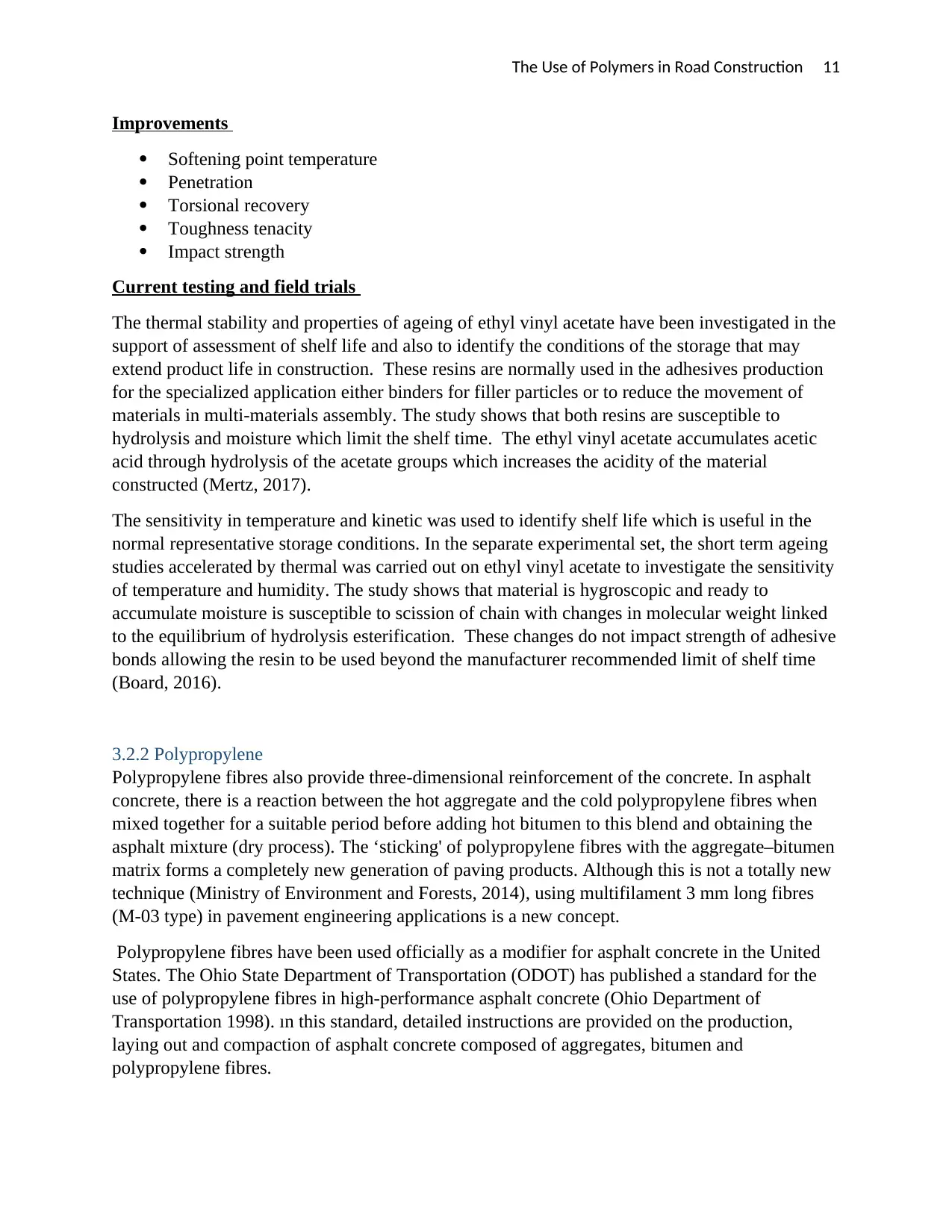
The Use of Polymers in Road Construction 11
Improvements
Softening point temperature
Penetration
Torsional recovery
Toughness tenacity
Impact strength
Current testing and field trials
The thermal stability and properties of ageing of ethyl vinyl acetate have been investigated in the
support of assessment of shelf life and also to identify the conditions of the storage that may
extend product life in construction. These resins are normally used in the adhesives production
for the specialized application either binders for filler particles or to reduce the movement of
materials in multi-materials assembly. The study shows that both resins are susceptible to
hydrolysis and moisture which limit the shelf time. The ethyl vinyl acetate accumulates acetic
acid through hydrolysis of the acetate groups which increases the acidity of the material
constructed (Mertz, 2017).
The sensitivity in temperature and kinetic was used to identify shelf life which is useful in the
normal representative storage conditions. In the separate experimental set, the short term ageing
studies accelerated by thermal was carried out on ethyl vinyl acetate to investigate the sensitivity
of temperature and humidity. The study shows that material is hygroscopic and ready to
accumulate moisture is susceptible to scission of chain with changes in molecular weight linked
to the equilibrium of hydrolysis esterification. These changes do not impact strength of adhesive
bonds allowing the resin to be used beyond the manufacturer recommended limit of shelf time
(Board, 2016).
3.2.2 Polypropylene
Polypropylene fibres also provide three-dimensional reinforcement of the concrete. In asphalt
concrete, there is a reaction between the hot aggregate and the cold polypropylene fibres when
mixed together for a suitable period before adding hot bitumen to this blend and obtaining the
asphalt mixture (dry process). The ‘sticking' of polypropylene fibres with the aggregate–bitumen
matrix forms a completely new generation of paving products. Although this is not a totally new
technique (Ministry of Environment and Forests, 2014), using multifilament 3 mm long fibres
(M-03 type) in pavement engineering applications is a new concept.
Polypropylene fibres have been used officially as a modifier for asphalt concrete in the United
States. The Ohio State Department of Transportation (ODOT) has published a standard for the
use of polypropylene fibres in high-performance asphalt concrete (Ohio Department of
Transportation 1998). ın this standard, detailed instructions are provided on the production,
laying out and compaction of asphalt concrete composed of aggregates, bitumen and
polypropylene fibres.
Improvements
Softening point temperature
Penetration
Torsional recovery
Toughness tenacity
Impact strength
Current testing and field trials
The thermal stability and properties of ageing of ethyl vinyl acetate have been investigated in the
support of assessment of shelf life and also to identify the conditions of the storage that may
extend product life in construction. These resins are normally used in the adhesives production
for the specialized application either binders for filler particles or to reduce the movement of
materials in multi-materials assembly. The study shows that both resins are susceptible to
hydrolysis and moisture which limit the shelf time. The ethyl vinyl acetate accumulates acetic
acid through hydrolysis of the acetate groups which increases the acidity of the material
constructed (Mertz, 2017).
The sensitivity in temperature and kinetic was used to identify shelf life which is useful in the
normal representative storage conditions. In the separate experimental set, the short term ageing
studies accelerated by thermal was carried out on ethyl vinyl acetate to investigate the sensitivity
of temperature and humidity. The study shows that material is hygroscopic and ready to
accumulate moisture is susceptible to scission of chain with changes in molecular weight linked
to the equilibrium of hydrolysis esterification. These changes do not impact strength of adhesive
bonds allowing the resin to be used beyond the manufacturer recommended limit of shelf time
(Board, 2016).
3.2.2 Polypropylene
Polypropylene fibres also provide three-dimensional reinforcement of the concrete. In asphalt
concrete, there is a reaction between the hot aggregate and the cold polypropylene fibres when
mixed together for a suitable period before adding hot bitumen to this blend and obtaining the
asphalt mixture (dry process). The ‘sticking' of polypropylene fibres with the aggregate–bitumen
matrix forms a completely new generation of paving products. Although this is not a totally new
technique (Ministry of Environment and Forests, 2014), using multifilament 3 mm long fibres
(M-03 type) in pavement engineering applications is a new concept.
Polypropylene fibres have been used officially as a modifier for asphalt concrete in the United
States. The Ohio State Department of Transportation (ODOT) has published a standard for the
use of polypropylene fibres in high-performance asphalt concrete (Ohio Department of
Transportation 1998). ın this standard, detailed instructions are provided on the production,
laying out and compaction of asphalt concrete composed of aggregates, bitumen and
polypropylene fibres.
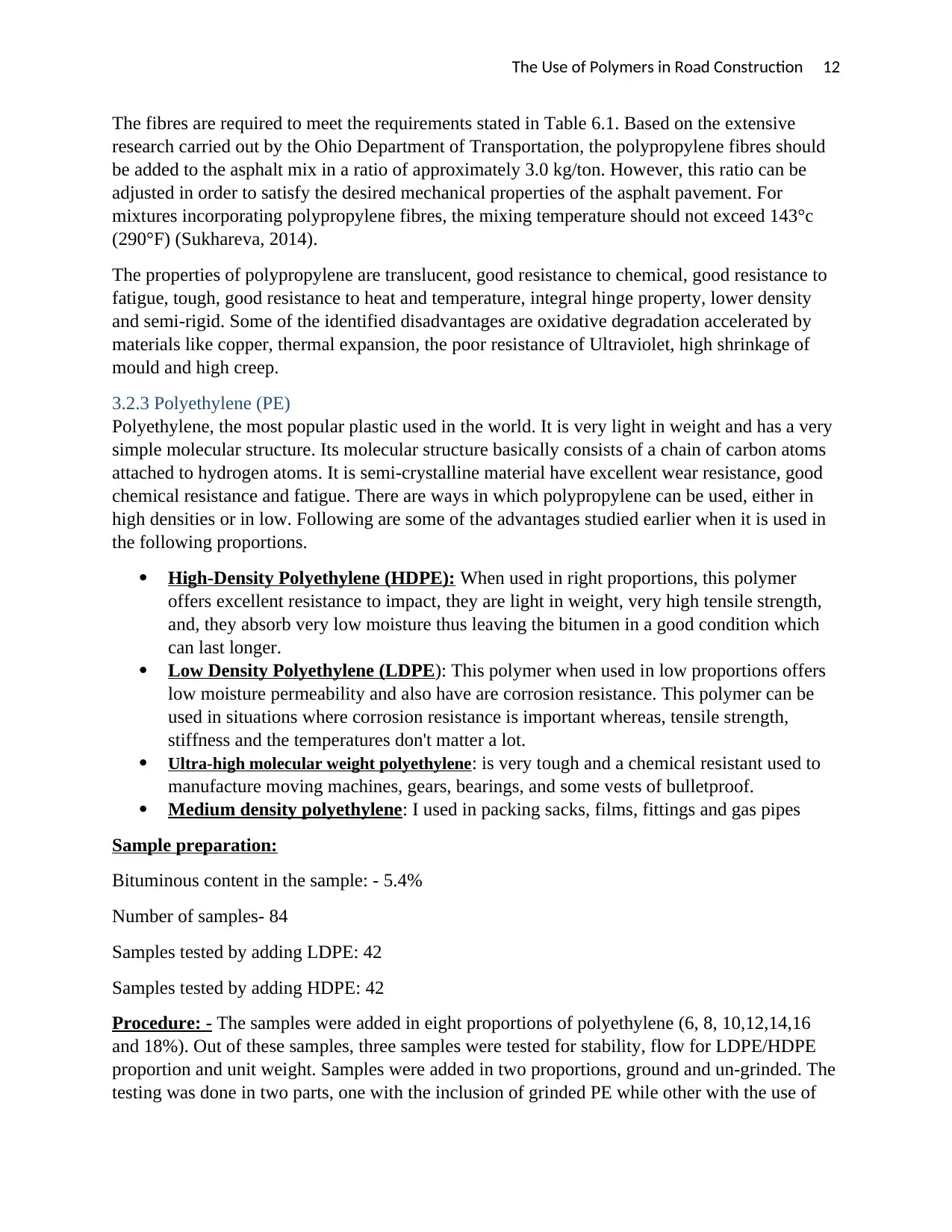
The Use of Polymers in Road Construction 12
The fibres are required to meet the requirements stated in Table 6.1. Based on the extensive
research carried out by the Ohio Department of Transportation, the polypropylene fibres should
be added to the asphalt mix in a ratio of approximately 3.0 kg/ton. However, this ratio can be
adjusted in order to satisfy the desired mechanical properties of the asphalt pavement. For
mixtures incorporating polypropylene fibres, the mixing temperature should not exceed 143°c
(290°F) (Sukhareva, 2014).
The properties of polypropylene are translucent, good resistance to chemical, good resistance to
fatigue, tough, good resistance to heat and temperature, integral hinge property, lower density
and semi-rigid. Some of the identified disadvantages are oxidative degradation accelerated by
materials like copper, thermal expansion, the poor resistance of Ultraviolet, high shrinkage of
mould and high creep.
3.2.3 Polyethylene (PE)
Polyethylene, the most popular plastic used in the world. It is very light in weight and has a very
simple molecular structure. Its molecular structure basically consists of a chain of carbon atoms
attached to hydrogen atoms. It is semi-crystalline material have excellent wear resistance, good
chemical resistance and fatigue. There are ways in which polypropylene can be used, either in
high densities or in low. Following are some of the advantages studied earlier when it is used in
the following proportions.
High-Density Polyethylene (HDPE): When used in right proportions, this polymer
offers excellent resistance to impact, they are light in weight, very high tensile strength,
and, they absorb very low moisture thus leaving the bitumen in a good condition which
can last longer.
Low Density Polyethylene (LDPE): This polymer when used in low proportions offers
low moisture permeability and also have are corrosion resistance. This polymer can be
used in situations where corrosion resistance is important whereas, tensile strength,
stiffness and the temperatures don't matter a lot.
Ultra-high molecular weight polyethylene: is very tough and a chemical resistant used to
manufacture moving machines, gears, bearings, and some vests of bulletproof.
Medium density polyethylene: I used in packing sacks, films, fittings and gas pipes
Sample preparation:
Bituminous content in the sample: - 5.4%
Number of samples- 84
Samples tested by adding LDPE: 42
Samples tested by adding HDPE: 42
Procedure: - The samples were added in eight proportions of polyethylene (6, 8, 10,12,14,16
and 18%). Out of these samples, three samples were tested for stability, flow for LDPE/HDPE
proportion and unit weight. Samples were added in two proportions, ground and un-grinded. The
testing was done in two parts, one with the inclusion of grinded PE while other with the use of
The fibres are required to meet the requirements stated in Table 6.1. Based on the extensive
research carried out by the Ohio Department of Transportation, the polypropylene fibres should
be added to the asphalt mix in a ratio of approximately 3.0 kg/ton. However, this ratio can be
adjusted in order to satisfy the desired mechanical properties of the asphalt pavement. For
mixtures incorporating polypropylene fibres, the mixing temperature should not exceed 143°c
(290°F) (Sukhareva, 2014).
The properties of polypropylene are translucent, good resistance to chemical, good resistance to
fatigue, tough, good resistance to heat and temperature, integral hinge property, lower density
and semi-rigid. Some of the identified disadvantages are oxidative degradation accelerated by
materials like copper, thermal expansion, the poor resistance of Ultraviolet, high shrinkage of
mould and high creep.
3.2.3 Polyethylene (PE)
Polyethylene, the most popular plastic used in the world. It is very light in weight and has a very
simple molecular structure. Its molecular structure basically consists of a chain of carbon atoms
attached to hydrogen atoms. It is semi-crystalline material have excellent wear resistance, good
chemical resistance and fatigue. There are ways in which polypropylene can be used, either in
high densities or in low. Following are some of the advantages studied earlier when it is used in
the following proportions.
High-Density Polyethylene (HDPE): When used in right proportions, this polymer
offers excellent resistance to impact, they are light in weight, very high tensile strength,
and, they absorb very low moisture thus leaving the bitumen in a good condition which
can last longer.
Low Density Polyethylene (LDPE): This polymer when used in low proportions offers
low moisture permeability and also have are corrosion resistance. This polymer can be
used in situations where corrosion resistance is important whereas, tensile strength,
stiffness and the temperatures don't matter a lot.
Ultra-high molecular weight polyethylene: is very tough and a chemical resistant used to
manufacture moving machines, gears, bearings, and some vests of bulletproof.
Medium density polyethylene: I used in packing sacks, films, fittings and gas pipes
Sample preparation:
Bituminous content in the sample: - 5.4%
Number of samples- 84
Samples tested by adding LDPE: 42
Samples tested by adding HDPE: 42
Procedure: - The samples were added in eight proportions of polyethylene (6, 8, 10,12,14,16
and 18%). Out of these samples, three samples were tested for stability, flow for LDPE/HDPE
proportion and unit weight. Samples were added in two proportions, ground and un-grinded. The
testing was done in two parts, one with the inclusion of grinded PE while other with the use of
⊘ This is a preview!⊘
Do you want full access?
Subscribe today to unlock all pages.

Trusted by 1+ million students worldwide
1 out of 29
Your All-in-One AI-Powered Toolkit for Academic Success.
+13062052269
info@desklib.com
Available 24*7 on WhatsApp / Email
![[object Object]](/_next/static/media/star-bottom.7253800d.svg)
Unlock your academic potential
Copyright © 2020–2025 A2Z Services. All Rights Reserved. Developed and managed by ZUCOL.

